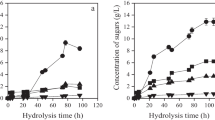Abstract
Utilization of lipids-free waxy starch by distillery yeasts in fuel ethanol production can contribute to better management of renewable resources, like cereals, especially maize Zea mays L. But the efficient conversion of starch into glucose-rich fermentable substrate, and subsequently to ethanol, needs more research on hydrolysis and fermentation conditions. The aim of this study was to evaluate the lack of natural corn grain lipids on the process of simultaneous saccharification and fermentation using chemometric techniques of designed experiments, commercial enzymatic preparations and distillery yeasts Saccharomyces cerevisiae CCY-11-3. Based on the results and statistical software support we can conclude that extraction of lipids from corn grains did not lead to statistically significant increase or decrease of glucose concentration in starch hydrolysis. The ethanol concentration in fermentation mash according to analysis was not statistically significantly affected by lipids extraction. The separated lipids could serve as a source of very valuable corn oil.
Similar content being viewed by others
References
Bryksa B.C. & Yada R.Y. 2009. Food biochemistry, pp. 57–84. In: Campbell-Platt G. (ed.), Food Science and Technology, John Wiley & Sons, Chichester.
Campos E.J., Quereshi N. & Blaschek H.P. 2002. Production of acetone butanol ethanol from degermed corn using Clostridium beijerinckii BA101. Appl. Biochem. Biotechnol. 98–100: 553–561.
Dickey L.C., Kurantz M.J., Johnston D.B., McAloon A.J. & Moreau R.A. 2010. Grinding and cooking dry-fractionated corn germ to optimize aqueous enzymatic oil extraction. Ind. Crops Products 32: 36–40.
Dziedzic S.Z. & Kearsley M.W. 1995. Handbook of Starch Hydrolysis Products and Their Derivates. Springer, 296 p.
Echt C.S. & Schwartz D. 1981. Evidence for the inclusion of controlling elements within the structural gene at the waxy locus in maize. Genetics 99: 275–284.
Ezeji T.C., Qureshi N. & Blaschek H.P. 2007. Butanol production from agricultural residues: impact of degradation products on Clostridium beijerinckii growth and butanol fermentation. Biotechnol. Bioeng. 97: 1460–1469.
Huang B.Q., Tian M.L., Zhang J.J. & Huang Y.B. 2010. Waxy locus and its mutant types in maize Zea mays L. Agric. Sci. China. 9: 1–10.
Huang J.J. & White P.J. 1993. Waxy corn starch: monoglyceride interaction in a model system. Cereal Chem. 70: 42–47.
Kálmán G. & Réczey K. 2007. Possible ways of bio-refining and utilizing the residual lignocelluloses of corn growing and processing. Chem. Eng. 51: 29–36.
Klösgen R.B., Gierl A., Schwarz-Sommer Z. & Saedler H. 1986. Molecular analysis of the waxy locus of Zea mays. Mol. Genet. Genomics 203: 237–244.
Kunamneni A. & Singh S. 2005. Response surface optimization of enzymatic hydrolysis of maize starch for higher glucose production. Biochem. Eng. J. 27: 179–190.
Lopes I.M.G. & Bernardo-Gil M.G. 2005. Characterisation of acorn oils extracted by hexane and by supercritical carbon dioxide. Eur. J. Lipid Sci. Technol. 107: 12–19.
Manikandan K. & Viruthagiri T. 2010. Kinetic and optimization studies on ethanol production from corn flour. Int. J. Environ. Sci. Tech. 3: 65–69.
Moreau R.A., Powell M.J. & Singh V. 2003. Pressurized liquid extraction of polar and nonpolar lipids in corn and oats with hexane, methylene chloride, isopropanol, and ethanol. J. Am. Oil Chem. Soc. 80: 1063–1067.
Murthy G.S., Singh V., Johnston D.B., Rausch K.D. & Tumbleson M. E. 2006. Improvement in fermentation characteristics of degermed ground corn by lipid supplementation, J. Ind. Microbiol. Biotechnol. 33: 655–660.
Nakazawa Y. & Wang Y.J. 2004. Effect of annealing on starchpalmitic acid interaction. Carbohydr. Polymers 57: 327–335.
Nelson O E. 1968. The waxy locus in maize. 11. The location of the controlling element alleles. Genetics 60: 507–524.
O’Brien R.D. 2009. Fats and Oils: Formulating and Processing for Applications. CRC Press, Boca Raton, 744 p.
Oderinde R.A., Esuoso K.O. & Adesogan E.K. 1990. The effect of lipids on the alcoholic fermentation of molasses using Saccharomyces cerevisiae. Mol. Nutr. Food Res. 34: 681–688.
Okagaki R.J. & Wessler S.R. 1988. Comparison of non-mutant and mutant waxy genes in rice and maize. Genetics 120: 1137–1143.
Ponnampalam E., Steele D.B., Burgdorf D. & McCalla D. 2004. Effect of germ and fiber removal on production of ethanol from corn. Appl. Biochem. Biotechnol. 113–116: 834–842.
Ratnam B.V.V., Narasimha Rao M., Damodar Rao M., Subba Rao S. & Ayyana C. 2003. Optimization of fermentation conditions for the production of ethanol from sago starch using response surface methodology. World J. Microbiol. Biotechnol. 19: 523–526.
Rathore S.S.S., Paulsen M.R., Sharma V. & Singh V. 2009. Optimization of yeast and enzyme dose for dry-grind corn fermentation process for ethanol production. Transactions ASABE 52: 867–875.
Sandhu K.S., Singh N. & Malhi N.S. 2007. Some properties of corn grains and their flours I: Physicochemical, functional and chapatimaking properties of fluors. Food Chem. 101: 938–946.
Tester R.F. & Morrison W.R. 1994. Properties of damaged starch granules. V. Composition and swelling of fractions of wheat starch in water at various temperatures. J. Cereal Sci. 20: 175–180.
Villwock V.K., Eliasson A.C., Silverio J. & BeMiller J.N. 1998. Starch-lipid interactions in common, waxy, ae du, and ae su2 maize starches examined by differential scanning calorimetry. Cereal Chem. 76: 292–298.
Walker G.M. 1998. Yeast Physiology and Biotechnology. John Wiley and Sons, Chichester, 353 p.
Whitt S.R., Wilson L.M., Tenaillon M.I., Gaut B.S. & Buckleriv E.S. 2002. Genetic diversity and selection in the maize starch pathway. Proc. Natl. Acad. Sci. USA 99: 12959–12962.
Wu X., Zhao R., Wang D., Bean S.R., Seib P.A., Tuinstra M.R., Campbell M. & O’Brien A. 2006. Effects of amylose, corn protein, and corn fiber contents on production of ethanol from starch rich media. Cereal Chem. 83: 569–575.
Zhao Y., Liu H.M. & Gu Y. 2008. Analysis of characteristic of codon usage in waxy gene of Zea mays. J. Maize Sci. 16: 16–21.
Author information
Authors and Affiliations
Corresponding author
Rights and permissions
About this article
Cite this article
Ondáš, V., Horváthová, V. & Šturdík, E. Lipids-free waxy corn starch as a substrate for distillery yeasts Saccharomyces cerevisiae . Biologia 66, 395–400 (2011). https://doi.org/10.2478/s11756-011-0047-9
Received:
Accepted:
Published:
Issue Date:
DOI: https://doi.org/10.2478/s11756-011-0047-9




